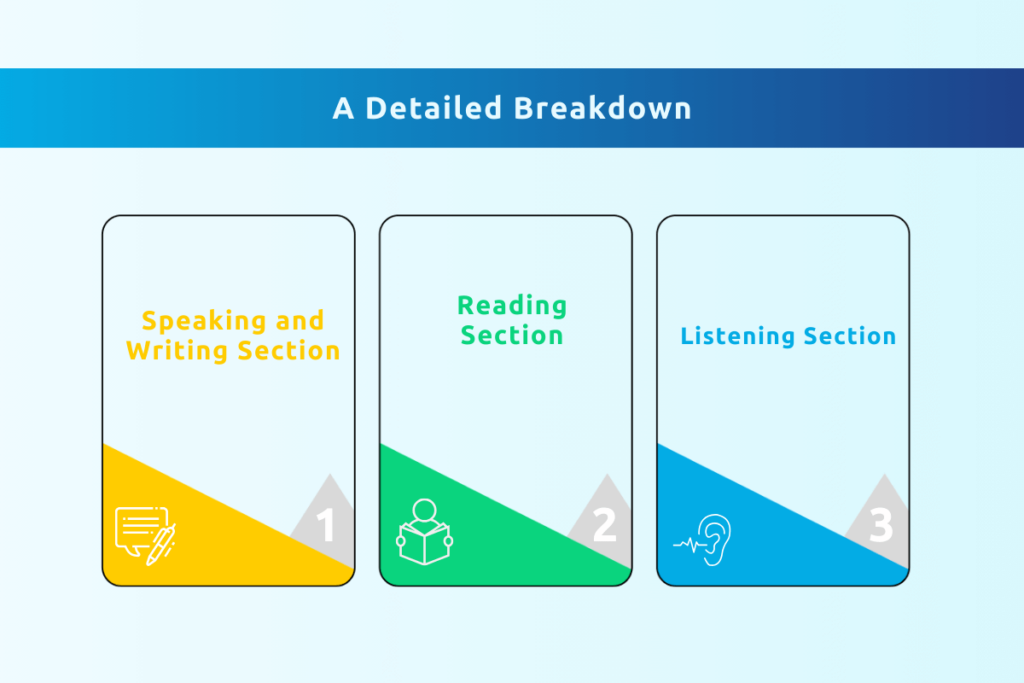Did you know that in India, more than 1.8 million English proficiency tests were conducted in the previous year, primarily for opportunities related to studying, immigrating, or working abroad?
Among these tests, the Pearson Test of English (PTE) is considered one of the most popular English proficiency tests worldwide. It is especially opted for by students and professionals aiming for higher education or immigration.

Excel in IELTS with India’s Top Online Coaching
Leap has helped more than 1 Lakh students achieve 7+ IELTS band.
Your PTE score in bands reflects your proficiency across different English language skills, providing a detailed assessment of your abilities.
This blog explores how the PTE score in bands is calculated, compares to other tests like IELTS, and why it is essential for academic and professional pursuits.
Here is a table showcasing the important information about the PTE exam.
| Aspect | Details |
|---|---|
| PTE Score in Bands | Scores range from A1 (basic) to C2 (expert), with a score range of 10-90 |
| PTE Score Validity | 2 years from the test date |
| Test Duration | 2 hours, including all sections |
| Score Availability | Available online within 48 hours of taking the test |
What is the PTE Scoring System?
The PTE scoring system is powered by artificial intelligence, ensuring an objective evaluation of your English skills. The overall score ranges from 10 to 90, calculated based on performance across integrated tasks.
Here’s something interesting: PTE is accepted in more than 70 countries and by over 3,000 institutions, opening doors to top universities worldwide!
You must also know that PTE has two types: academic and general.
The PTE score in bands is derived from these individual skill scores and is mapped to CEFR (Common European Framework of Reference for Languages) levels from A1 (beginner) to C2 (expert).
Types of Scoring in PTE
- Correct/Incorrect: Some questions are scored using a simple correct/incorrect method.
- Partial Credit: Integrated skills tasks, such as essay writing or summarising spoken text, allow for partial credit. You may receive partial credit for partially correct responses, making every point critical to achieving a higher band PTE score.
Also Read: PTE Exam 2024: Dates, Fees, Results, Syllabus & Pattern
The PTE Band Score Chart
The PTE band score chart is the primary reference for interpreting your overall and individual section scores.
The global English assessment market is valued at £1 billion, with the PTE band score chart playing a critical role in university admissions, visa applications, and job recruitment. Many universities and immigration departments use the PTE score in bands to assess language proficiency, ensuring you can succeed academically and professionally.
The table below shows the PTE score range equivalent to the CEFR level and the proficiency description.
| PTE Score Range | CEFR Level | Proficiency Description |
|---|---|---|
| 10-29 | A1 | Basic phrases and expressions |
| 30-42 | A2 | Simple communication in familiar situations |
| 43-58 | B1 | Basic command of the language in everyday contexts |
| 59-75 | B2 | Fluent communication with minor errors |
| 76-84 | C1 | Effective communication across complex scenarios |
| 85-90 | C2 | Full proficiency, near-native command |
The PTE score in bands reflects these levels, enabling you to see where your abilities stand based on international standards.
Now that you’ve grasped the conversion of PTE score range and their CEFR levels, examining the detailed breakdown of score ranges is essential. Read the next section!

Excel in IELTS with India’s Top Online Coaching
Leap has helped more than 1 Lakh students achieve 7+ IELTS band.
Detailed Breakdown of PTE Score Ranges
Each PTE band score represents different levels of language proficiency.
Here is a breakdown of what each score range signifies.
- 10-29 (A1): This band indicates fundamental use of the English language. Test takers at this level understand and use everyday phrases and simple interactions.
- 30-42 (A2): This score signifies the ability to handle familiar topics and daily exchanges but with limited expression.
- 43-58 (B1): A solid grasp of routine communication, allowing participation in conversations about familiar matters. You can express opinions but may struggle with more complex discussions.
- 59-75 (B2): Your command of the language is vital at this band. You can engage in complex conversations, although occasional errors might occur.
- 76-84 (C1): Test takers at this level are effective communicators who can easily handle professional and social situations.
- 85-90 (C2): A rare level of proficiency comparable to native speakers, allowing for smooth and accurate communication across any topic.
Understanding PTE scores in bands will help you know exactly where you stand and what improvement might be needed to achieve your goals.
How PTE Marks Convert into Bands?
Understanding how PTE marks convert into bands is crucial, as it helps you gauge your performance more effectively. The system is automated and AI-based, ensuring precise and objective results. Your score is derived from integrated tasks that evaluate your speaking, listening, reading, and writing skills.
The table below outlines the score range and the bands based on the skill being tested.
| Skill | Score Range | Band |
|---|---|---|
| Speaking | 10-90 | A1-C2 |
| Writing | 10-90 | A1-C2 |
| Reading | 10-90 | A1-C2 |
| Listening | 10-90 | A1-C2 |
The PTE score in bands reflects your cumulative performance across these sections. With partial credit applied in some instances, such as when more than one correct answer is possible, it is vital to understand how your PTE score converts into bands accurately.
Another important fact to consider is that your PTE results will be available online within 48 hours of completing the test.
After recognising the implications of your PTE score in bands, it is time for you to look at the PTE test format in the next section!
Explore all countries
PTE Test Format: A Detailed Breakdown
The PTE test format evaluates your proficiency in English across four key language skills: Speaking, Writing, Reading, and Listening.
This computer-based test utilises advanced AI to assess your responses, ensuring accurate and unbiased scoring.
The test lasts 2 hours and consists of various integrated tasks where multiple skills are tested simultaneously.
Below is a detailed breakdown of the PTE test format helping you understand the structure and prepare effectively.

| Speaking and Writing | 54-67 minutes | Read Aloud Repeat Sentence Describe Image, Essay, etc |
| Reading | 29-30 minutes | Multiple-choice Re-order Paragraphs Fill in the Blanks |
| Listening | 30-43 minutes | Summarise Spoken Text Write from Dictation Highlight Words, etc |
1. Speaking and Writing Section
This is the first part of the test, designed to evaluate your ability to communicate effectively in spoken and written English. Since PTE is an integrated skills test, this section will evaluate your speaking and writing skills through various tasks.
The tasks included in this section are as follows.
- Personal Introduction: This part is unscored but allows you to introduce yourself. It’s useful for institutions that will review your results.
- Read Aloud: You will read a text on the screen aloud, testing your reading ability.
- Repeat Sentence: A short sentence will be played, and you’ll need to repeat it exactly as you heard it. This tests your listening and speaking skills.
- Describe Image: An image will appear on the screen (e.g., a chart, graph, or photograph), and you’ll describe it in detail within 40 seconds.
- Re-tell Lecture: Summarise a lecture in your own words after listening to or watching it.
- Answer Short Questions: You will hear a question and need to give a brief answer, often just one or two words.
- Summarise Written Text: You will read and summarise a text into one sentence, focusing on the key points. This assessment will assess your reading and writing skills.
- Essay Writing: You will write an essay (200-300 words) responding to a prompt. The essay will test your ability to develop ideas clearly and logically in written English.
2. Reading Section
The Reading section assesses your ability to understand written English. It comprises different question types that test your comprehension, interpretation, and ability to identify key points in written texts.
Tasks in this section include the following.
- Multiple-choice, Single Answer: After reading a passage, you will select the correct answer from a list of options. Only one answer is correct.
- Multiple-choice, Multiple Answers: Similar to the single-answer format, multiple correct options exist. You have to select all the correct answers.
- Re-order Paragraphs: Several text boxes will appear, and you must arrange them correctly to form a coherent paragraph.
- Reading: Fill in the Blanks: You will see text with gaps, and you must drag the correct word from a list of options into each gap.
- Reading and Writing: Fill in the Blanks: This task also involves filling in gaps in a text, but here, the blanks are related to reading and writing skills.
3. Listening Section
The Listening section evaluates your ability to understand spoken English, including identifying key points and summarising information. You will listen to audio clips, such as lectures, conversations, and monologues.
Tasks in this section include the following.
- Summarise Spoken Text: After listening to a lecture or dialogue, you’ll write a summary (50-70 words) that captures the main points. This task evaluates your listening and writing skills.
- Multiple-choice, Multiple Answers: After listening to an audio clip, you’ll select the correct answers from several options.
- Fill in the Blanks: You’ll listen to a recording and fill in the missing words in an audio transcript.
- Highlight the Correct Summary: You will hear a recording and select the summary that best matches the information you heard.
- Multiple-choice, Single Answer: Similar to the multiple-answer task but with only one correct answer.
- Select Missing Word: The final word or phrase in a recording will be beeped out, and you’ll need to choose the correct missing word from a list.
- Highlight Incorrect Words: When listening to a recording, you’ll be given a transcript where some words have been altered. You’ll need to highlight the words said incorrectly.
- Write from Dictation: You will hear a short sentence and write it down exactly as you heard it. This tests both listening and writing skills.
Conversion of PTE Scores
Many test-takers are curious about how the PTE score converts into bands in other popular tests, such as the IELTS and TOEFL.
Below is a comparison table to understand how your PTE marks align with your IELTS band system.
| IELTS | PTE Core (Overall) | PTE Core (Listening, Reading, Speaking, Writing) |
|---|---|---|
| 5 | 40.8 | Listening: 40.2 Reading: 43.0 Speaking: 40.2 Writing: 43.1 |
| 5.5 | 45.4 | Listening: 42.7 Reading: 47.9 Speaking: 42.2 Writing: 51.0 |
| 6 | 51.6 | Listening: 48.1 Reading: 53.5 Speaking: 46.2 Writing: 62.2 |
| 6.5 | 58.5 | Listening: 56.8 Reading: 60.6 Speaking: 53.5 Writing: 74.1 |
| 7 | 66.3 | Listening: 66.2 Reading: 67.6 Speaking: 65.3 Writing: 82.3 |
| 7.5 | 74.6 | Listening: 73.9 Reading: 73.7 Speaking: 75.3 Writing: 87.5 |
| 8 | 82.3 | Listening: 9.4 Reading: 78.4 Speaking: 80.9 Writing: 89.4 |
Using this PTE score chart with IELTS, you can see how your scores might translate if you consider multiple tests for visa or university applications.
Want to achieve a 7+ IELTS score? Let our experts at Leap Scholar guide you with personalised guidance and expert tips. Join our Free LIVE Masterclass today and start your journey!
Also Read: PTE To IELTS Conversion: IELTS vs PTE Score Chart 2024
If you plan to use your PTE Academic scores for university applications or visa purposes, remember that they are valid for up to 2 years from your exam date.
Conversion of PTE Score to TOEFL
| PTE Core Score | TOEFL Score |
|---|---|
| 84 – 90 | 120 |
| 80 – 84 | 115 – 119 |
| 75 – 80 | 109 – 115 |
| 70 – 75 | 102 – 109 |
| 65 – 70 | 95 – 102 |
| 60 – 65 | 89 – 95 |
| 55 – 60 | 82 – 89 |
| 50 – 55 | 74 – 82 |
| 45 – 50 | 63 – 74 |
| 40 – 45 | 48 – 63 |
| 0 – 40 | 0 – 48 |
Practical Use of the PTE Score Chart
For test takers, the PTE score converted into a bands chart is more than just a reference guide. It becomes a tool to set goals, track improvements, and align performance with the requirements of universities or professional bodies.
If you need to score a 65 in the PTE to meet university entry standards, you know that you’ll need to aim for a B2 or higher on the band scale.
You must also know that PTE Academic scores are valid for up to 2 years from your exam date.
PTE Score in Bands: Impact on University Admissions
Universities often require candidates to submit English language test scores for their application requirements. Understanding your PTE score in bands is crucial, as universities usually specify the minimum band required for admission to undergraduate or postgraduate programs.
The table below summarises the PTE score requirements for undergraduate and postgraduate programs.
| Program Type | Required PTE Band | PTE Score Range |
|---|---|---|
| Undergraduate Programs | B1 or B2 | 43-75 |
| Postgraduate Programs | C1 | 76-84 |
Knowing how your PTE marks convert into bands can help you determine the specific score you need for your academic goals.
PTE Score in Bands: Visa Applications
Immigration authorities commonly reference the PTE band score chart when applying for a work or study visa. Countries like Australia and New Zealand use PTE scores converted into bands to assess English proficiency for visa applications. For example, Australia requires a minimum B2 level (PTE score of 65 or higher) for most work and skilled visas.
Understanding your PTE score in bands is key to meeting visa requirements for your desired destination.
Also Read: Minimum PTE Score Required For Australia in 2025
Tips for Improving Your PTE Score in Bands
Achieving a high PTE score in bands requires targeted preparation. Here are a few tips to help you improve.
- Focus on All Skills Equally: Don’t just concentrate on your overall PTE score. Universities and immigration bodies often require minimum scores in individual skills (speaking, writing, reading, listening). Make sure each section meets the required band.
- Practise Integrated Tasks: Since PTE assesses multiple skills in one task, focus on practising these questions to enhance your overall performance.
- Utilise Mock Tests: Take regular mock tests to understand your current band PTE score and focus on areas that need improvement. This also familiarises you with the exam format.
- Review Speaking and Writing Feedback: Speaking and writing tasks often involve partial credit. Review your mistakes in these sections and learn how to provide more accurate and well-structured responses.
- Understand Band Conversion: Many candidates misunderstand how PTE marks convert into bands. For example, an overall band of C1 (PTE score of 76) may seem sufficient, but a lower band in one skill, such as writing, can impact your application. Be mindful of your skill scores.
- Improve Time Management: Time management is crucial during the PTE exam. Ensure you allocate enough time to each section and don’t rush through questions, especially in integrated tasks.
- Expand Vocabulary: A strong vocabulary can enhance your performance in reading and listening sections. Read academic articles and newspapers and hear podcasts to improve your understanding of different topics.
- Stay Updated with the Latest PTE Practices: Visit the official PTE website frequently to check for any exam format or scoring updates. Engage with online forums or groups to gather other test-takers latest tips and insights.
Also Read: PTE Exam Preparation 2024: Section-wise Tips & Tricks
Understanding the PTE score in bands is essential for anyone aiming to take the test in 2025. By familiarising yourself with the PTE band score chart, you can set realistic goals and enhance your chances of achieving the score you need for your plans.
Frequently Asked Questions
-
Q. What is the PTE score in bands?
Ans. The PTE score in bands is a way to measure your English proficiency across different language skills, including speaking, reading, writing, and listening. The overall PTE score ranges from 10 to 90 and is converted into band levels from A1 (beginner) to C2 (expert) to represent your proficiency. This system provides a clear, internationally recognised indication of your language abilities.
-
Q. How is the PTE score converted into bands?
Ans. The PTE score is converted into bands based on your performance across all test sections. This conversion follows the CEFR scale, which allows you to understand your level of English proficiency. The PTE score converted into bands ranges from A1 (basic) to C2 (native-like). This ensures that your score aligns with other global standards of language assessment.
-
Q. What is the PTE band score chart used for?
Ans. The PTE band score chart helps you understand your overall performance by mapping your PTE score to international proficiency levels. It is useful for comparing your results with tests like IELTS and gauging the required proficiency for university admissions or visa applications. This comparison can simplify your application process by identifying exact requirements.
-
Q. How do PTE marks convert into bands?
Ans. PTE marks are converted into bands by evaluating your scores across different sections—speaking, writing, reading, and listening. The PTE score converted into bands helps determine your overall proficiency, using a scale from A1 to C2, reflecting your language abilities accurately. This process ensures you receive a balanced evaluation across all language skills.
-
Q. Can I compare my PTE score with IELTS using a score chart?
Ans. Yes, a PTE score chart with IELTS allows you to compare your PTE scores with IELTS bands. This chart shows the equivalent scores for both tests, helping you understand where your PTE score stands in relation to the IELTS scoring system. This can be particularly helpful if you’re considering multiple options for language tests.
-
Q. What is the significance of the PTE band score chart?
Ans. The PTE band score chart is crucial for understanding your language proficiency level. It helps test-takers see where they stand based on the CEFR levels, ranging from A1 to C2, making it easier to determine your eligibility for university admissions or visa requirements. It also gives a clear indication of areas where further improvement is needed.
-
Q. How does the PTE band score chart help in university admissions?
Ans. The PTE band score chart provides clarity on the minimum English proficiency required by universities. Many institutions set specific band scores, such as B1 or B2, as a benchmark for admission into undergraduate or postgraduate programs. It helps you understand the level of language skills you need to meet for successful admission.
-
Q. Can PTE marks be converted into bands for all sections?
Ans. Yes, PTE marks into bands are calculated for each section—speaking, reading, writing, and listening. The scores from these sections are converted into a final band, which represents your overall proficiency on the CEFR scale. This breakdown enables you to identify strengths and weaknesses across different skills. As a result, you can focus on improving specific areas if needed.
-
Q. Is there a PTE score chart with IELTS for visa applications?
Ans. Yes, many visa authorities use a PTE score chart with IELTS to compare the English proficiency of applicants. This chart helps convert PTE scores into equivalent IELTS bands, making it easier to meet the language requirements for visa applications. Having this comparison ensures you meet visa requirements based on the specific test you’ve taken. It also provides a clearer path to meeting immigration or visa criteria.
-
Q. How does the PTE band score chart help with test preparation?
Ans. The PTE band score chart allows you to track your progress and set clear goals. By understanding how your PTE score converts into bands, you can focus on improving specific skills, such as speaking or writing, to reach the required proficiency level. This targeted approach helps you strategize effectively and focus on areas needing improvement. This also gives you a more structured path to achieving your desired score.
-
Q. How does the PTE score convert into bands for immigration purposes?
Ans. Yes, many immigration bodies accept PTE scores, and the PTE score converted into bands helps you understand if you meet the required language proficiency for visa applications. This makes it easier to align your scores with immigration policies. It provides a clear measure to assess whether you meet the language requirements for immigration programs. Additionally, this helps you compare your score with other accepted language assessments used for immigration.















Have Questions? Get Guidance to reach your Dream University
Connect with India's finest counsellors and biggest study abroad community.
Get Guidance